Complete Solutions to SECTION A of chapter FOOTSTEPS TOWARDS CBSE BOARD of Class 9 book with complete answers and questions
| Class 9 | BIOLOGY |
| Chapter | FOOTSTEPS TOWARDS CBSE BOARD |
| MTG IIT JEE FOUNDATION | SECTION A |
| Number Of Questions | 45 |
| Academic Year | 2023-24 |
What is meristems
View SolutionName different parts of a neuron.
View SolutionWrite down the roles of plasma membrane and cell wall.
View SolutionWhat is the other name of Japanese encephalitis?
View SolutionWho discovered the vaccine for smallpox?
View SolutionName three functional regions of a cell.
View SolutionName the following tissues: found in the iris of the eye.
View SolutionName the following tissues: present in the brain.
View SolutionName the tissue which allows easy bending in various parts of a plant.
View SolutionWhat are pathogens ? Give examples.
View SolutionName the complex plant tissues.
View SolutionWhat is prokaryotic cell ?
View SolutionWhat is the name given to the undefined nuclear region of prokaryotic cell?
View SolutionName the deficiency disease caused due to deficiency of vitamin A
View SolutionName the deficiency disease caused due to deficiency of vitamin `B_1`
View SolutionGive one local and one general effect of inflammation process.
View SolutionWhat is the full form of ATP?
View SolutionWhy are mitochondria called semi-autonomous organelles?
View SolutionName any two diseases which occur due to mosquito bites.
View SolutionName two diseases which can be prevented by using vaccines.
View SolutionWhich cell organelle is synthesised by the Golgi apparatus?
View SolutionAssertion: Parenchyma and collenchyma tissues act as mechanical tissue to plants.
Reason: Parenchyma and collenchyma form an important part of the bark of trees.
View SolutionAssertion : Cell wall is a non-living part of the cell.
Reason : Cell wall offers protection, definite shape and support.
View SolutionAssertion : Lysosmes are capable of digesting carbohydrates, proteins, lipids and nucleic acids.
Reason : Lysosomes are rich in hydrolytic enzuymes like lipases, proteases and carbohydrases.
View SolutionAssertion : It is safe to sit near a person suffering from cold.
Reason : Cold is a non-communicable disease.
View SolutionOrganelle X bears ribosomes on its outer surface. Organelle X and organelle Y together give rise to organelle Z which is often referred to as 'suicide bag' of cells
Organelle X, Y and Z are respectively
View SolutionOrganelle X bears ribosomes on its outer surface. Organelle X and organelle Y together give rise to organelle Z which is often referred to as 'suicide bag' of cells
Select the incorrect statement regarding X, Y and Z.
View SolutionOrganelle X bears ribosomes on its outer surface. Organelle X and organelle Y together give rise to organelle Z which is often referred to as 'suicide bag' of cells
Organelle X was discovered by
View SolutionOrganelle X bears ribosomes on its outer surface. Organelle X and organelle Y together give rise to organelle Z which is often referred to as 'suicide bag' of cells
Which of the following is not a function of organelle Y?
View SolutionOrganelle X bears ribosomes on its outer surface. Organelle X and organelle Y together give rise to organelle Z which is often referred to as 'suicide bag' of cells
Which of the following organelles is absent in mature mammalian RBCs?
View SolutionAn eukaryotic cell possesses true nucleus bounded by nuclear membrane. Other membrane bound organelles are also present in an eukaryotic cell.
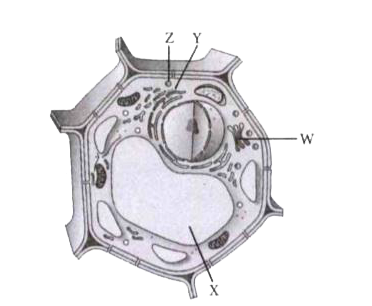
identify W,X,Y and Z
View SolutionAn eukaryotic cell possesses true nucleus bounded by nuclear membrane. Other membrane bound organelles are also present in an eukaryotic cell.
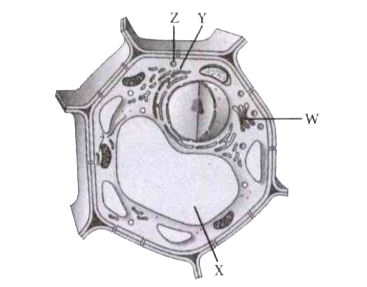
The covering membrane of X is known as
View SolutionAn eukaryotic cell possesses true nucleus bounded by nuclear membrane. Other membrane bound organelles are also present in an eukaryotic cell.
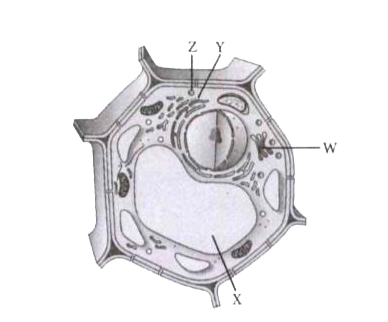
Which of the following organelles contains hydrolytic enzymes?
View SolutionAn eukaryotic cell possesses true nucleus bounded by nuclear membrane. Other membrane bound organelles are also present in an eukaryotic cell.
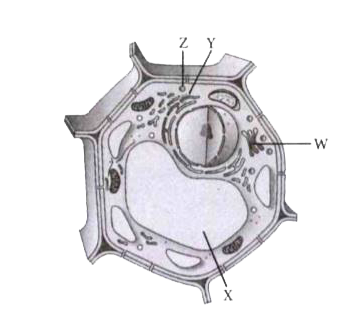
Among the organelles W, X, Y and Z which one takes part in storage, modification and packaging of various materials?
View SolutionAn eukaryotic cell possesses true nucleus bounded by nuclear membrane. Other membrane bound organelles are also present in an eukaryotic cell.
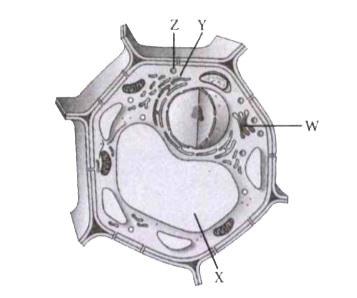
Organelle Y is
View SolutionA tissue is a group of similar cells held together by a cementing substance produced by them, for performing a specific function. There are two types of tissue in plants i.e., meristematic tissue and permanent tissue. Meristematic tissue are found in all growing parts of plants such as root and shoot tips. These are called apical meristem. The tissue occurs right from the birth of plant, are called primary meristems. Permanent tissue arise from meristematic tissue and constitute major portion of the plant body. These includes simple and complex tissues. Simple tissues are parenchyma, sclerenchyma and collenchyma, complex tissue are xylem and phloem.
Parenchyma arises from
View SolutionA tissue is a group of similar cells held together by a cementing substance produced by them, for performing a specific function. There are two types of tissue in plants i.e., meristematic tissue and permanent tissue. Meristematic tissue are found in all growing parts of plants such as root and shoot tips. These are called apical meristem. The tissue occurs right from the birth of plant, are called primary meristems. Permanent tissue arise from meristematic tissue and constitute major portion of the plant body. These includes simple and complex tissues. Simple tissues are parenchyma, sclerenchyma and collenchyma, complex tissue are xylem and phloem.
Which cells have the ability to divide?
View SolutionA tissue is a group of similar cells held together by a cementing substance produced by them, for performing a specific function. There are two types of tissue in plants i.e., meristematic tissue and permanent tissue. Meristematic tissue are found in all growing parts of plants such as root and shoot tips. These are called apical meristem. The tissue occurs right from the birth of plant, are called primary meristems. Permanent tissue arise from meristematic tissue and constitute major portion of the plant body. These includes simple and complex tissues. Simple tissues are parenchyma, sclerenchyma and collenchyma, complex tissue are xylem and phloem.
The xylem in plants are responsible for
View SolutionA tissue is a group of similar cells held together by a cementing substance produced by them, for performing a specific function. There are two types of tissue in plants i.e., meristematic tissue and permanent tissue. Meristematic tissue are found in all growing parts of plants such as root and shoot tips. These are called apical meristem. The tissue occurs right from the birth of plant, are called primary meristems. Permanent tissue arise from meristematic tissue and constitute major portion of the plant body. These includes simple and complex tissues. Simple tissues are parenchyma, sclerenchyma and collenchyma, complex tissue are xylem and phloem.
Four students observed parenchyma tissue and drew following diagrams. Which one is correct?
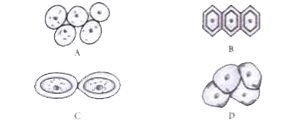
View SolutionA tissue is a group of similar cells held together by a cementing substance produced by them, for performing a specific function. There are two types of tissue in plants i.e., meristematic tissue and permanent tissue. Meristematic tissue are found in all growing parts of plants such as root and shoot tips. These are called apical meristem. The tissue occurs right from the birth of plant, are called primary meristems. Permanent tissue arise from meristematic tissue and constitute major portion of the plant body. These includes simple and complex tissues. Simple tissues are parenchyma, sclerenchyma and collenchyma, complex tissue are xylem and phloem.
__________ transports product of photosynthesis from the leaves where they are synthesised, to other parts of the plant.
View SolutionX and Y are type of diseases. X can spread from an infected person to a healthy person by actual contact between them and can spread from an infected person to healthy person with food, air or water. Y remains confined to the person who develops them and do not spread to others.
Identify X and Y.

View SolutionX and Y are type of diseases. X can spread from an infected person to a healthy person by actual contact between them and can spread from an infected person to healthy person with food, air or water. Y remains confined to the person who develops them and do not spread to others.
Some examples of X are
View SolutionX and Y are type of diseases. X can spread from an infected person to a healthy person by actual contact between them and can spread from an infected person to healthy person with food, air or water. Y remains confined to the person who develops them and do not spread to others.
Which of the following is protozoan pathogen?
View SolutionX and Y are type of diseases. X can spread from an infected person to a healthy person by actual contact between them and can spread from an infected person to healthy person with food, air or water. Y remains confined to the person who develops them and do not spread to others.
All the given are examples of X except
View SolutionX and Y are type of diseases. X can spread from an infected person to a healthy person by actual contact between them and can spread from an infected person to healthy person with food, air or water. Y remains confined to the person who develops them and do not spread to others.
Suman is having low blood pressure, frequent stools with blood and dehydration. She might be suffering from a
View Solution
SECTION A questions and complete solutions for chapter FOOTSTEPS TOWARDS CBSE BOARD of MTG IIT JEE FOUNDATION of Class 9